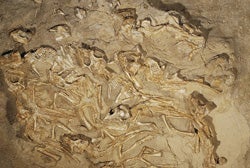Big Discovery of Little Dinosaurs
 A 70-million-year-old nest containing the fossilized remains of 15 Protoceratops andrewsi dinosaurs found in Mongolia has given scientists a new understanding of how that group of dinosaurs cared for their young. It is the first nest of this genus ever found and the first indication that Protoceratops juveniles remained in the nest for an extended period.
A 70-million-year-old nest containing the fossilized remains of 15 Protoceratops andrewsi dinosaurs found in Mongolia has given scientists a new understanding of how that group of dinosaurs cared for their young. It is the first nest of this genus ever found and the first indication that Protoceratops juveniles remained in the nest for an extended period.
“Death likely occurred during a desert sandstorm. My guess is that the initial and present-day dryness contributed significantly to the superb preservation, not just of Protoceratops, but of all the fossils from this unit,” said paleontologist David Fastovsky, who is the lead author of the study.
“Finding juveniles in a nest is a relatively uncommon occurrence, and I cannot think of another dinosaur specimen that preserves 15 juveniles in its nest in this way,” the professor of geosciences added.
An analysis of the nest by Fastovsky and his colleagues found that all 15 dinosaurs—at least 10 of which are complete specimens—were about 6 inches tall and about a year old. The discovery also indicates that the young dinosaurs remained in the nest through the early stages of their development and were cared for by their parents.
The relatively large number of offspring may have been a way of ensuring the survival of the species. They lived in a stressful environment alongside other dinosaurs, including the notorious Velociraptor dinosaur, which probably ate young Protoceratops.
 Home
Home Browse
Browse Close
Close Events
Events Maps
Maps Email
Email Brightspace
Brightspace eCampus
eCampus


